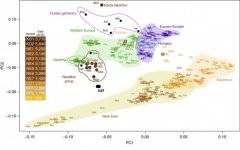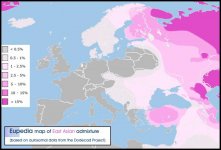We can then turn to the Alans and the Huns:
As to the Alans, here is what I have found:
"Archaeological finds support the written sources. P. D. Rau (1927) first identified late Sarmatian sites with the historical Alans. Based on the archaeological material, they were one of the Iranian-speaking nomadic tribes that began to enter the Sarmatian area between the middle of the 1st and the 2nd centuries."
"By the beginning of the 1st century, the Alans had occupied lands in the northeast
Azov Sea area, along the
Don and by the 2nd century had amalgamated or joined with the Yancai of the early Chinese records to extend their control all the way along the trade routes from the
Black Sea to the north of the Caspian and Aral seas. The written sources suggest that from the end of the 1st century to the second half of the 4th century the Alans had supremacy over the tribal union and created a powerful confederation of Sarmatian tribes.
From a Western point-of-view the Alans presented a serious problem for the
Roman Empire, with incursions into both the Danubian and the Caucasian provinces in the 2nd and 3rd centuries."
Also,
"Roman sources first mention the Alani in the 1st century and later describe them as a warlike people who specialized in horse breeding. They frequently raided the
Parthian empire and the Caucasian provinces of the Roman Empire. In the Vologeses inscription
[17] one can read that
Vologeses I, the Parthian king c. AD 51-78, in the 11th year of his reign, battled
Kuluk, king of the Alani."
Here is a map of the Alan incursions. It does show some pillaging, or whatever, into northern Italy, but it's similar to the rest of western Europe, and there's nothing in southern Italy.
http://en.wikipedia.org/wiki/Alans#mediaviewer/File:Alani_map.jpg*
Now let's look at the Huns.
In that regard, some of the comments in the Avar article bear repeating.
"Such views are mirrored by
Csanad Balint. "The
ethnogenesis of early medieval peoples of steppe origin cannot be conceived in a
single linear fashion due to their great and constant mobility", with no ethnogenetic "point zero", theoretical "proto-people" or proto-language.
[13]
The name for a new group of steppe riders was often taken from a repertoire of prestigious names which did not necessarily denote any direct affiliation to or descent from groups of the same name; in the early middle ages, Huns, Avars,
Bulgars, and Ogurs, or names connected with -(o)gur (
Cutrigurs,
Utigurs,
Onogurs, etc.), were most important. In the process of name-giving, both perceptions by outsiders and self-designation played a role. These names were also connected with prestigious traditions that directly expressed political pretensions and programmes, and had to be endorsed by success. In the world of the steppe, where agglomerations of groups were rather fluid, it was vital to know how to deal with a newly-emergent power. The symbolical hierarchy of prestige expressed through names provided some orientation for friend and foe alike."
"The
Huns were a
nomadic people or peoples, who are known to have lived in
Eastern Europe, the
Caucasus and
Central Asia between the 1st century AD and the 7th century. They were first reported living east of the
Volga River, in an area that was part of
Scythia at the time; the Huns' arrival is associated with the migration westward of a Scythian people, the
Alans.
[1] They were first mentioned as Hunnoi by
Tacitus. In 91 AD, the Huns were said to be living near the
Caspian Sea and by about 150 AD had migrated southeast into the
Caucasus.
[2] By 370 AD, the Huns had established a vast, if short-lived, dominion in Europe.
There is no scholarly consensus on a direct connection between the dominant element of the Xiongnu and that of the Huns.
[4] Priscus mentions that the Huns had a
language of their own; little of it has survived and its relationships have been the subject of debate for centuries. Numerous other languages were spoken within the Hun Empire, including
Gothic (East Germanic). Their main military technique was
mounted archery.
Their descendants, or successors with similar names, are recorded by neighbouring populations to the south, east and west as having occupied parts of
Eastern Europe and
Central Asia approximately from the 4th century to the 6th century. Variants of the Hun name are recorded in the
Caucasus until the early 8th century.
Contemporary literary sources do not have a clear consensus of the Hun origins. The Huns seem to "suddenly appear", first mentioned during an attack on the
Alans, who are generally connected to the
River Don (
Tanais). Scholarship from the early 20th century literature connected the sudden and apparently devastating Hun appearance as a predatory migration from the more easterly parts of the
steppe, i.e. Central Asia.
More recent theories view the nomadic confederacies, such as the Huns, as the formation of several different cultural, political and linguistic entities that could dissolve as quickly as they formed, entailing a process of
ethnogenesis.
[8][9][10] A group of "warrior" horse-nomads would conquer and/or be joined by other warrior groups throughout western Eurasia, and in turn extracted tribute over a territory that included other social and ethnic groups, including sedentary agricultural peoples. In steppe society, clans could forge new alliances and subservience by incorporating other clans, creating a new common ancestral lineage descended from an early heroic leader. Thus, one cannot expect to find a clear origin. "All we can say safely," says
Walter Pohl, "is that the name Huns, in
late antiquity (4th century), described prestigious ruling groups of steppe warriors."
[9]
This is the Hunnic empire at its height.
http://upload.wikimedia.org/wikipedia/commons/4/43/Huns_empire.png
In 451, Attila's forces entered
Gaul, accumulating contingents from the
Franks,
Goths and
Burgundian tribes en route. Once in Gaul, the Huns first attacked
Metz, then his armies continued westwards, passing both Paris and
Troyes to lay siege to
Orléans.
Many Huns were employed as mercenaries by both East and West Romans and by the Goths.
Uldin, the first Hun known by name,
[15] headed a group of Huns and Alans fighting against Radagaisus in defense of Italy.
Leading his horde across the Alps and into Northern Italy, he sacked and razed the cities of
Aquileia,
Vicetia,
Verona,
Brixia,
Bergamum and
Milan. Hoping to avoid the sack of Rome, Emperor Valentinian III sent three envoys, the high civilian officers Gennadius Avienus and Trigetius, as well as
Pope Leo I, who met Attila at
Mincio in the vicinity of
Mantua, and obtained from him the promise that he would withdraw from Italy and negotiate peace with the emperor.
That tangential reference is the only one that I can find with regard to the Huns, and it applies only to northern Italy, and involves only a battle and some raiding.
So, if you want to leave out the Mongols, go ahead for now. There's plenty of "eastern" "Iranic" ancestry pumping into Russia, the Slavic areas, central Hungary, and the Balkans without them.
Ed.*There is a little offshoot after much traveling into Sicily.




